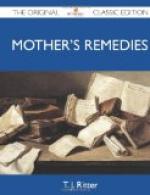Symptoms.—Of course, upon examination this split is seen. It may involve not only the hard palate, but also the soft palate and uvula. It is then generally accompanied by single or double hare-lip. When the severe forms occur they cause great trouble. Fluids pass freely into the nose, and unless the child is carefully fed by hand it will soon die, as it is unable to suck. In the less severe forms the child soon learns to swallow properly, but when he learns to speak he cannot articulate properly and his voice is nasal.
Treatment.—For this reason an early operation is advisable, not so early as for hare-lip, but before the child has learned to speak, say between the age of three and four when faulty speech (articulation) may be overcome by successful closure of the palate. When the operation is done late, the patient will not be able to overcome the bad habits of articulation acquired in his childhood.
[370 Mothers’ remedies]
Operation.—The anaesthetic is necessary. The end of one-half of the cleft palate is seized with an instrument and the edge freely pared with a thin bladed sharp knife; same with the other half. Then the stitches are put in of silk worm, gut or wire. The patient is fed on liquid food for three or four days, and afterwards on soft food until the stitches are removed. They are removed about the sixth or eighth day, and the wound should be completely healed.
Crooked feet. Talipes.—There are many varieties. The treatment should be begun, under the instructions of a physician, and continued from infancy and many a good foot can be obtained.
Knock knee. (Genu Valgum).—This is due to an overgrowth of the internal knuckle (condyle) on the knee joint, and curving inward of the shaft of the thigh-bone (femur) in its lower parts, with relaxation and lengthening of the ligaments of the knee joint.
It usually shows itself soon after the child begins to walk, but may not do so until puberty,—rarely later. It is due in the child to rickets; in the latter form, it is caused by an occupation that requires continued standing, by a person of feeble development of the muscles and ligaments. “Flat-foot” is often associated with it and, at times, may be the real cause. It may affect one or both knees, may be so slight as to escape detection, except upon a very careful examination, or so severe as to separate the feet very widely and render walking difficult and wobbling. In children other symptoms of rickets can generally be found. If not severe it may often get better spontaneously as the rickets condition improves and the general strength increases. This result is common in the cases occurring later, from standing if the general condition improves.
Treatment.—Should be begun early and both general and local treatment should be given. The quicker the treatment is begun, the quicker will be the recovery and the deformity will be less. The ordinary medical and hygienic treatment should be given for rickets.




